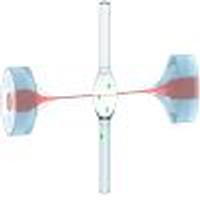Our official English website, www.x-mol.net, welcomes your
feedback! (Note: you will need to create a separate account there.)
Nanoparticle sensing beyond evanescent field interaction with a quasi-droplet microcavity
Optica ( IF 8.4 ) Pub Date : 2018-05-22 , DOI: 10.1364/optica.5.000674 Jonathan M. Ward , Yong Yang , Fuchuan Lei , Xiao-Chong Yu , Yun-Feng Xiao , Síle Nic Chormaic
Optica ( IF 8.4 ) Pub Date : 2018-05-22 , DOI: 10.1364/optica.5.000674 Jonathan M. Ward , Yong Yang , Fuchuan Lei , Xiao-Chong Yu , Yun-Feng Xiao , Síle Nic Chormaic

|
Sensing with whispering gallery resonators (WGRs) is largely limited by the weak perturbation of the whispering gallery mode (WGM) via the evanescent field. A new sensing regime using quasi-droplet WGMs allows WGRs to move beyond the limitation of the evanescent field and push the detection sensitivity to new heights. We present experimental results on the detection of 100 nm and 500 nm polystyrene particles in aqueous solution using thin-walled, hollow WGRs supporting quasi-droplet modes. The detection sensitivity in terms of mode shift and broadening is measured, with mode shifts of 400 MHz observed for 100 nm particles. In terms of the number of linewidths, this is 276 times larger than similar experiments with microsphere WGRs, thus showing a significant increase in detection sensitivity beyond the capability of standard evanescent field sensing with WGRs.
中文翻译:

纳米粒子感测与e滴微腔之间的e逝场相互作用之外
回音壁谐振器(WGR)的感应很大程度上受到回音场模式(WGM)通过van逝场的微弱干扰的限制。一种使用准液滴WGM的新的感应方式允许WGR超越beyond逝场的限制,并将检测灵敏度推向新的高度。我们提出了使用支持准液滴模式的薄壁空心WGR检测水溶液中100 nm和500 nm聚苯乙烯颗粒的实验结果。测量了关于模式偏移和展宽的检测灵敏度,对于100 nm粒子观察到400 MHz的模式偏移。就线宽数量而言,这是使用微球WGR进行的类似实验的276倍,
更新日期:2018-06-22
中文翻译:

纳米粒子感测与e滴微腔之间的e逝场相互作用之外
回音壁谐振器(WGR)的感应很大程度上受到回音场模式(WGM)通过van逝场的微弱干扰的限制。一种使用准液滴WGM的新的感应方式允许WGR超越beyond逝场的限制,并将检测灵敏度推向新的高度。我们提出了使用支持准液滴模式的薄壁空心WGR检测水溶液中100 nm和500 nm聚苯乙烯颗粒的实验结果。测量了关于模式偏移和展宽的检测灵敏度,对于100 nm粒子观察到400 MHz的模式偏移。就线宽数量而言,这是使用微球WGR进行的类似实验的276倍,











































 京公网安备 11010802027423号
京公网安备 11010802027423号